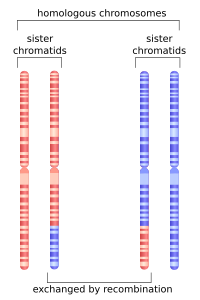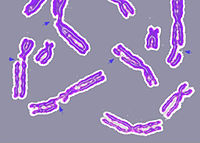
Non‐homologous end joining: Common interaction sites and exchange of multiple factors in the DNA repair process
Sign Up to like & getrecommendations! Published in 2017 at "BioEssays"
DOI: 10.1002/bies.201600209
Abstract: Non‐homologous end‐joining (NHEJ) is the dominant means of repairing chromosomal DNA double strand breaks (DSBs), and is essential in human cells. Fifteen or more proteins can be involved in the detection, signalling, synapsis, end‐processing and… read more here.
Keywords: end joining; end; homologous end; interaction ... See more keywords

Multi-substrate selectivity based on key loops and non-homologous domains: new insight into ALKBH family
Sign Up to like & getrecommendations! Published in 2020 at "Cellular and Molecular Life Sciences"
DOI: 10.1007/s00018-020-03594-9
Abstract: AlkB homologs (ALKBH) are a family of specific demethylases that depend on Fe 2+ and α-ketoglutarate to catalyze demethylation on different substrates, including ssDNA, dsDNA, mRNA, tRNA, and proteins. Previous studies have made great progress… read more here.
Keywords: family; key loops; homologous domains; alkbh family ... See more keywords

A curious new role for MRN in Schizosaccharomyces pombe non-homologous end-joining
Sign Up to like & getrecommendations! Published in 2017 at "Current Genetics"
DOI: 10.1007/s00294-017-0760-1
Abstract: Chromosomal breaks can be healed by several repair processes, including one called non-homologous end-joining (NHEJ) where the two broken ends are ligated together with a loss of 0–5 bp of DNA. The protein requirements for NHEJ… read more here.
Keywords: end joining; schizosaccharomyces pombe; homologous end; mrn ... See more keywords

Deletion of yeast TPK1 reduces the efficiency of non-homologous end joining DNA repair.
Sign Up to like & getrecommendations! Published in 2020 at "Biochemical and biophysical research communications"
DOI: 10.1016/j.bbrc.2020.09.083
Abstract: Non-homologous end joining (NHEJ) is a highly conserved mechanism of DNA double-stranded break (DSB) repair. Here we utilize a computational protein-protein interaction method to identify human PRKACB as a potential candidate interacting with NHEJ proteins.… read more here.
Keywords: end joining; deletion; homologous end; tpk1 ... See more keywords

Inhibition of non-homologous end joining in Fanconi Anemia cells results in rescue of survival after interstrand crosslinks but sensitization to replication associated double-strand breaks.
Sign Up to like & getrecommendations! Published in 2018 at "DNA repair"
DOI: 10.1016/j.dnarep.2018.02.003
Abstract: When Fanconi Anemia (FA) proteins were depleted in human U2OS cells with integrated DNA repair reporters, we observed decreases in homologous recombination (HR), decreases in mutagenic non-homologous end joining (m-NHEJ) and increases in canonical NHEJ,… read more here.
Keywords: end joining; fanconi anemia; homologous end; replication associated ... See more keywords

Growth stimulatory effect of AHL producing Serratia spp. from potato on homologous and non-homologous host plants.
Sign Up to like & getrecommendations! Published in 2020 at "Microbiological research"
DOI: 10.1016/j.micres.2020.126506
Abstract: Plant growth promoting rhizobacteria are known to improve plant performance by developing healthy and productive interactions with the host plants. These associations may be symbiotic or asymbiotic depending upon the genetic potential of the resident… read more here.
Keywords: growth; plant; hsl; potato ... See more keywords

MRI Is a DNA Damage Response Adaptor during Classical Non-homologous End Joining.
Sign Up to like & getrecommendations! Published in 2018 at "Molecular cell"
DOI: 10.1016/j.molcel.2018.06.018
Abstract: The modulator of retrovirus infection (MRI or CYREN) is a 30-kDa protein with a conserved N-terminal Ku-binding motif (KBM) and a C-terminal XLF-like motif (XLM). We show that MRI is intrinsically disordered and interacts with… read more here.
Keywords: end joining; dna damage; damage response; classical non ... See more keywords

Development of versatile non-homologous end joining-based knock-in module for genome editing
Sign Up to like & getrecommendations! Published in 2017 at "Scientific Reports"
DOI: 10.1038/s41598-017-18911-9
Abstract: CRISPR/Cas9-based genome editing has dramatically accelerated genome engineering. An important aspect of genome engineering is efficient knock-in technology. For improved knock-in efficiency, the non-homologous end joining (NHEJ) repair pathway has been used over the homology-dependent… read more here.
Keywords: end joining; knock; genome editing; homologous end ... See more keywords

LINP1 facilitates DNA damage repair through non-homologous end joining (NHEJ) pathway and subsequently decreases the sensitivity of cervical cancer cells to ionizing radiation
Sign Up to like & getrecommendations! Published in 2018 at "Cell Cycle"
DOI: 10.1080/15384101.2018.1442625
Abstract: ABSTRACT LncRNA in non-homologous end joining (NHEJ) pathway 1 (LINP1) is an lncRNA which promotes therapeutic resistance in triple-negative breast cancer (TNBC). However, the expression and function of LINP1 in cervical cancer is not yet… read more here.
Keywords: end joining; cervical cancer; homologous end; nhej pathway ... See more keywords

PREQUAL: detecting non-homologous characters in sets of unaligned homologous sequences
Sign Up to like & getrecommendations! Published in 2018 at "Bioinformatics"
DOI: 10.1093/bioinformatics/bty448
Abstract: Summary Phylogenomic datasets invariably contain undetected stretches of non-homologous characters due to poor-quality sequences or erroneous gene models. The large-scale multi-gene nature of these datasets renders impractical or impossible detailed manual curation of sequences, but… read more here.
Keywords: homologous sequences; homologous characters; unaligned homologous; prequal detecting ... See more keywords

Dicer regulates non-homologous end joining and is associated with chemosensitivity in colon cancer patients
Sign Up to like & getrecommendations! Published in 2017 at "Carcinogenesis"
DOI: 10.1093/carcin/bgx059
Abstract: DNA double-strand break (DSB) repair is an important mechanism underlying chemotherapy resistance in human cancers. Dicer participates in DSB repair by facilitating homologous recombination. However, whether Dicer is involved in non-homologous end joining (NHEJ) remains… read more here.
Keywords: chemosensitivity colon; non homologous; colon cancer; dicer ... See more keywords